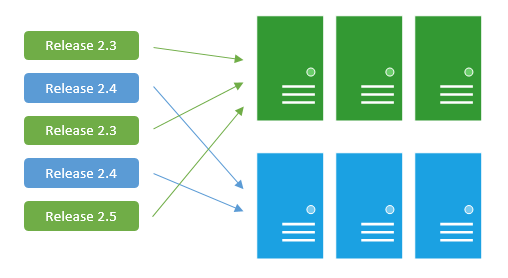https://octopus.com/docs/deployment-patterns/canary-deployments
https://martinfowler.com/bliki/CanaryRelease.html
Canary deployments are a pattern for rolling out releases to a subset of users or servers. The idea is to first deploy the change to a small subset of servers, test it, and then roll the change out to the rest of the servers. The canary deployment serves as an early warning indicator with less impact on downtime: if the canary deployment fails, the rest of the servers aren't impacted.
The basic steps of a canary deployment are:
- Deploy to one or more canary servers.
- Test, or wait until satisfied.
- Deploy to the remaining servers.
The test phase of the canary deployment can work in many ways. You could run some automated tests, perform manual testing yourself, or even leave the server live and wait to see if problems are encountered by end users. In fact, all three of these approaches might be used. Depending on how you plan to test, you might decide to remove the canary server from the production load balancer and return it only when rolling out the change to the rest of the servers.
Similar to staging Canary deployments are similar to using a staging environment. The difference is that staging environments are usually dedicated to the task; a staging web server doesn't become a production server. By contrast, in a canary deployment, the canary server remains part of the production fleet when the deployment is complete. Canary deployments may be worth considering if you do not have the resources to have a dedicated staging environment.
https://octopus.com/docs/deployment-patterns/blue-green-deployments
https://martinfowler.com/bliki/BlueGreenDeployment.html
Blue-green deployments are a pattern whereby we reduce downtime during production deployments by having two production environments ("blue" and "green").
In a blue-green deployment model, the production environment changes with each release:
As well as reducing downtime, Blue-Green can be a powerful way to use extra hardware compared to having a dedicated staging environment:
- Staging: when blue is active, green becomes the staging environment for the next deployment.
- Rollback: we deploy to blue and make it active. Then a problem is discovered. Since green still runs the old code, we can roll back easily.
- Disaster recovery: after deploying to blue and we're satisfied that it is stable, we can deploy the new release to green too. This gives us a standby environment ready in case of disaster.
https://martinfowler.com/articles/feature-toggles.html
Feature Toggles (often also refered to as Feature Flags) are a powerful technique, allowing teams to modify system behavior without changing code. They fall into various usage categories, and it's important to take that categorization into account when implementing and managing toggles. Toggles introduce complexity. We can keep that complexity in check by using smart toggle implementation practices and appropriate tools to manage our toggle configuration, but we should also aim to constrain the number of toggles in our system.

